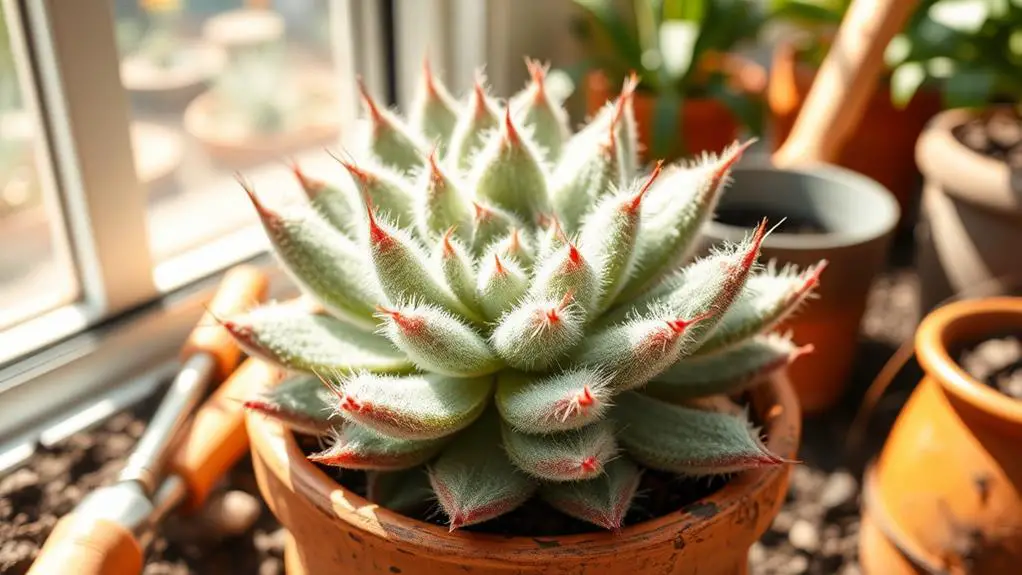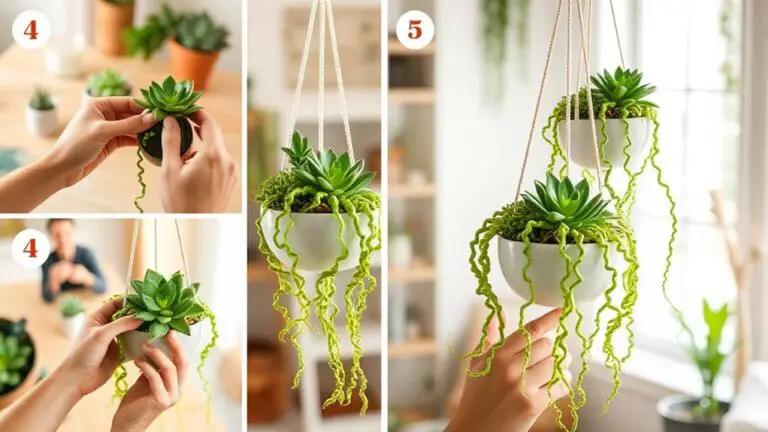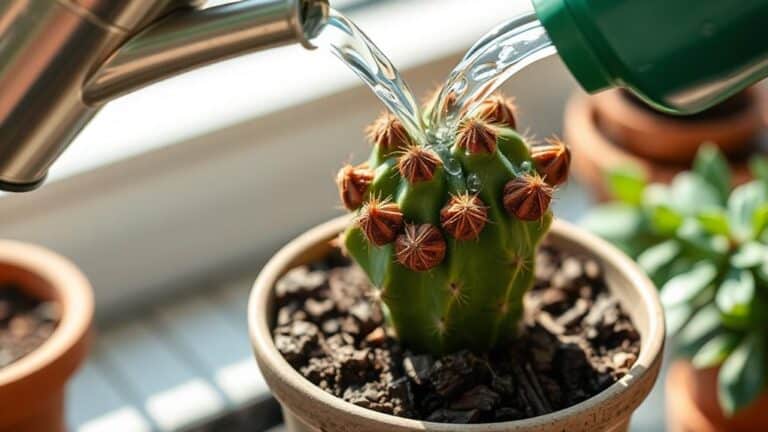Ultimate Guide to Kalanchoe Tomentosa Care and Propagation
Caring for Kalanchoe tomentosa, or the "Panda Plant," involves understanding its unique needs to guarantee it thrives in your home. You'll want to focus on providing the right light, temperature, and soil conditions to mimic its natural habitat. Bright, indirect sunlight and well-draining soil are essential, but there's more to it than just the basics. Have you wondered how to propagate this charming succulent effectively or troubleshoot common issues? Stick around to discover expert tips and techniques that will keep your Panda Plant healthy and vibrant.
Origin and Characteristics
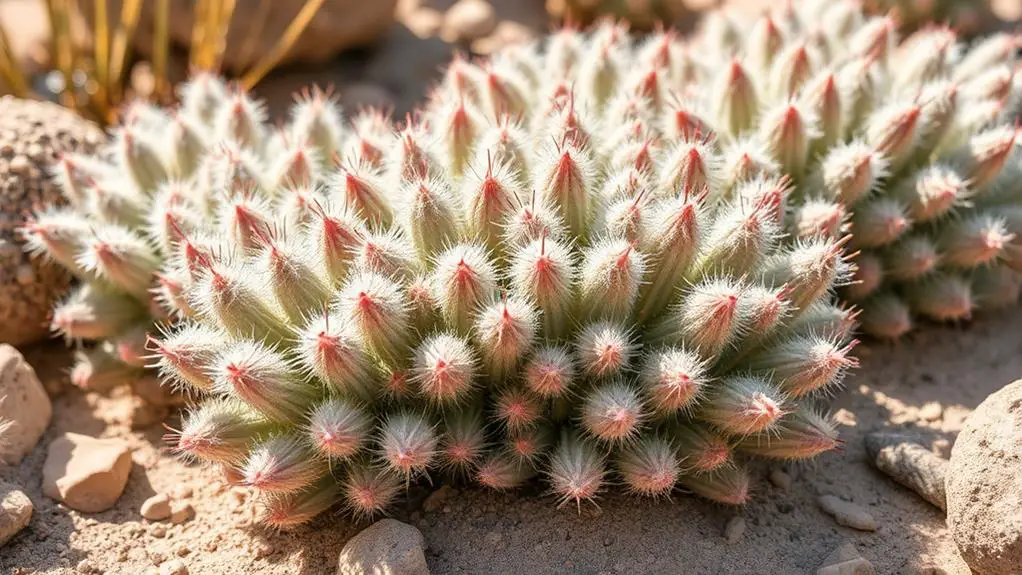
Kalanchoe tomentosa, better known as the panda plant, hails from the rocky landscapes of Madagascar. As a member of the Crassulaceae family, this succulent is easy to love for its unique look and hardy nature.
You'll notice its velvety, fleshy leaves, which are silver-green with striking brownish-red edges. These leaves typically form a rosette, creating a visually appealing pattern.
Native to Madagascar, the panda plant thrives in rocky environments. This adaptability comes from its fine hairs covering the leaves, which help retain water. These hairs make it well-suited for dry conditions, giving you a low-maintenance plant that doesn't need constant watering.
Under the right conditions, it can grow up to 2 feet tall, although it rarely flowers indoors. If you're lucky enough to see it bloom outdoors, expect green, purple, or yellow flowers from March to June.
Being part of the Crassulaceae family means the panda plant is related to other popular succulents. This connection adds to its charm and resilience, making it a great choice for both beginner and seasoned gardeners.
Enjoy growing this unique and beautiful plant!
Popular Varieties
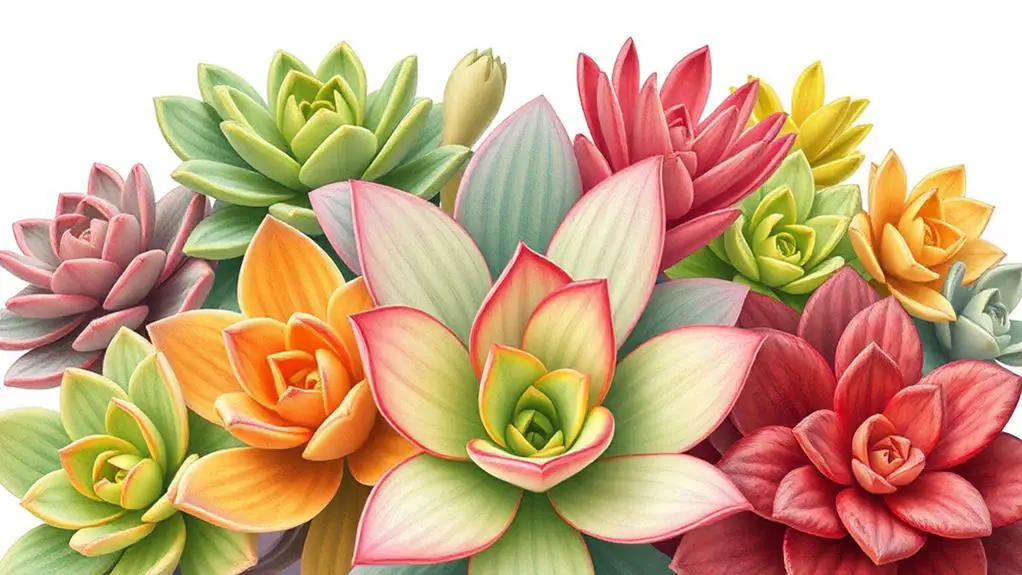
When exploring the popular varieties of Kalanchoe tomentosa, you'll often find a delightful range of leaf characteristics that make each one unique.
One of the most beloved varieties is the Chocolate Soldier. Its narrow leaves have a pale coloration with chocolate brown edges, giving it a distinctive look. The leaves are soft and velvety, adding to its charm.
Another fascinating variety is the Nigra. This one is known for its dark brown edges that can appear almost black. The edges can be dotted or form a continuous pattern, making each plant look special. If you're drawn to darker tones, Nigra might be your favorite.
The Rubra variety is truly eye-catching with its reddish leaves. Under bright light, these leaves can shimmer with a golden-red hue. It's a stunning sight and adds a splash of color to your collection.
Then there's the Fang variety, which stands out due to its pronounced leaf tips. Like all Kalanchoe tomentosa plants, Fang also features those signature velvety leaves.
Light Requirements
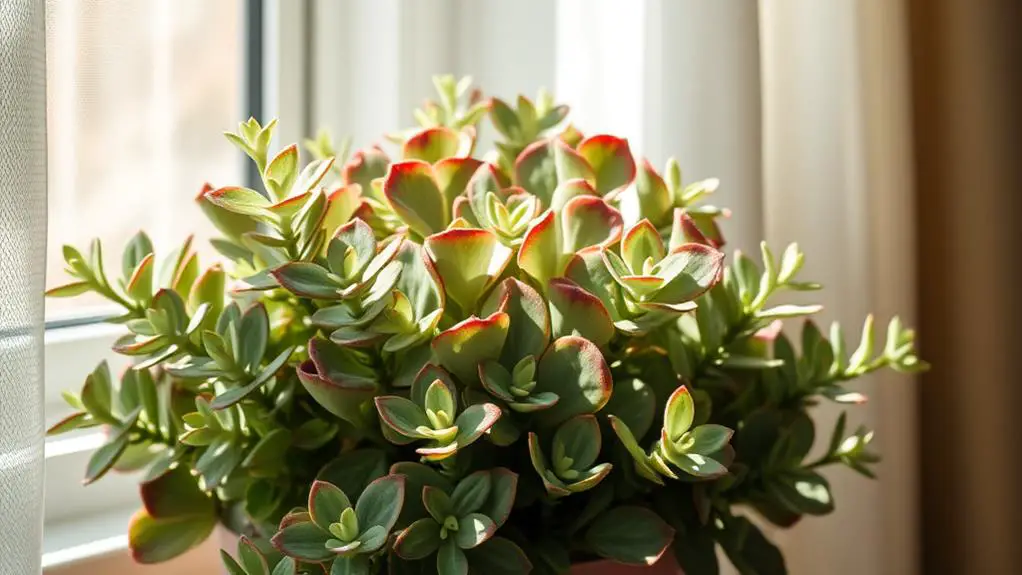
Exploring the unique varieties of Kalanchoe tomentosa is an enthralling journey, but to keep these plants looking their best, understanding their light requirements is key.
Your Kalanchoe tomentosa thrives in bright, indirect light, which helps enhance its leaf color and overall health. Although it can tolerate some direct sunlight, avoid excessive exposure, especially during midday, as it can scorch the leaves.
If your plant doesn't get enough light, it may become leggy, stretching toward the nearest light source. To avoid this, place your Kalanchoe tomentosa near south or west-facing windows where it can receive filtered light throughout the day. This setup provides the perfect balance of brightness without risking leaf damage.
Remember to rotate your plant periodically. This guarantees even light exposure, promoting balanced growth and preventing uneven legging.
When caring for your Kalanchoe tomentosa, combining proper light conditions with well-draining soil will keep it healthy and vibrant. The right light helps your plant maintain its beautiful form, rewarding your efforts with lush, colorful leaves.
With these tips, your Kalanchoe tomentosa will be a stunning addition to your home.
Temperature and Humidity
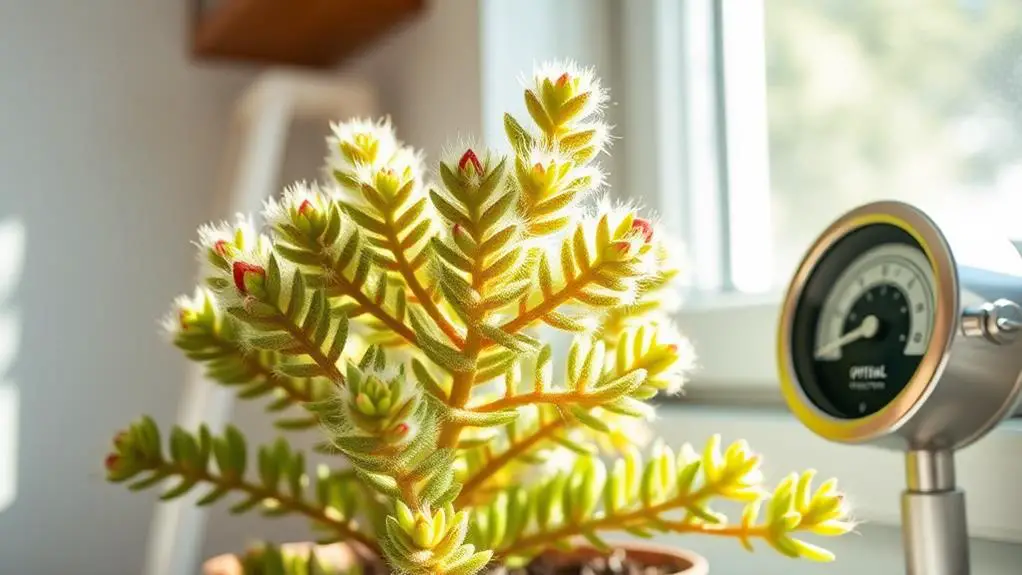
In maintaining a healthy Kalanchoe tomentosa, keeping an eye on temperature and humidity is crucial. This succulent thrives in temperatures between 60°F to 75°F (15°C to 24°C), making it perfect for most indoor settings.
It's important to avoid exposing your plant to frost, as cold temperatures can cause significant damage. While Kalanchoe tomentosa can handle slight temperature variations, extreme heat or cold can hinder its growth and overall health.
Low humidity levels are preferable for this plant. High humidity can lead to fungal infections, which can prevent healthy growth. You don't need to worry about misting your Kalanchoe tomentosa; it's better to keep the air dry around it.
A well-ventilated room is perfect for maintaining the right humidity.
During the winter, the plant enters a dormancy period. During this time, you should reduce the frequency of watering and make sure the temperatures remain within the best range.
This practice helps prevent root rot, which can be a major issue if the plant is kept too wet and cold. By maintaining the right temperature and humidity, you'll support your Kalanchoe tomentosa's health and vibrant growth.
Soil and Potting
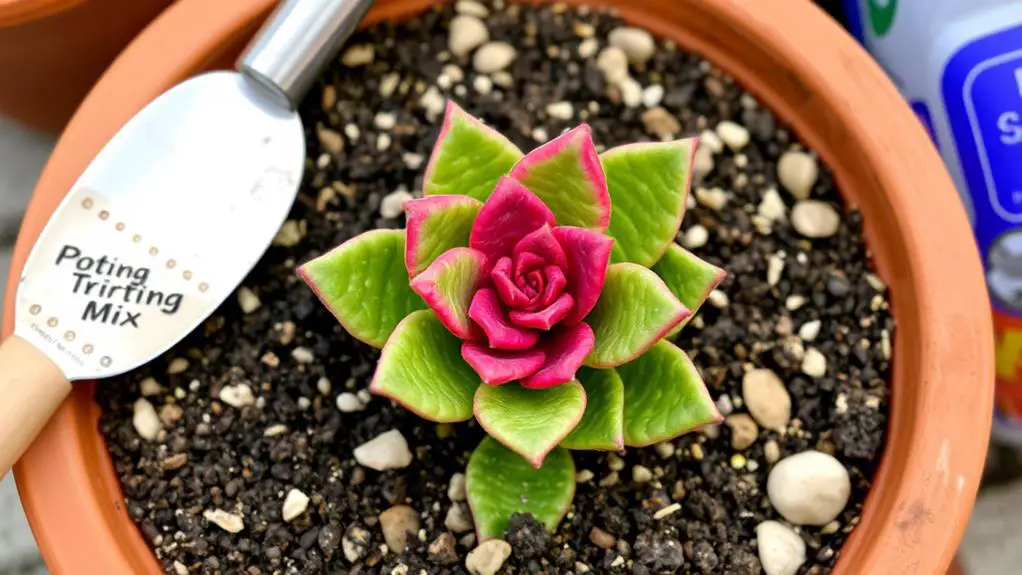
To keep your Kalanchoe tomentosa thriving, start with a well-draining succulent or cactus potting mix to prevent root rot.
Choose pots with drainage holes, and terracotta ones are great for breathability and moisture control.
Repotting every 2-3 years guarantees fresh soil and enough room for root growth, keeping your plant happy and healthy.
Ideal Soil Composition
A key to keeping your Kalanchoe tomentosa healthy and thriving lies in the soil composition.
You'll need a well-draining soil mix to help prevent root rot, which is a common issue with succulents. A cactus or succulent potting mix is ideal for this plant. These mixes usually contain sand, perlite, or pumice, which help the soil drain quickly.
Make certain that the soil doesn't retain too much moisture. Kalanchoe tomentosa thrives in drier environments, so a heavy, moisture-retentive soil can cause problems. If you notice the soil staying wet for too long, it's a sign that it's not draining well enough.
When you pot your Kalanchoe tomentosa, use a container with drainage holes. This allows excess water to escape, keeping the roots healthy and preventing root rot.
It's also a good idea to repot your plant every 2-3 years or when it outgrows its pot. This guarantees that the roots have adequate space and that the soil remains aerated.
Proper Pot Selection
Ensuring your Kalanchoe tomentosa thrives involves not just the right soil but also selecting the proper pot. A well-draining potting mix specifically for succulents or cacti is essential. This mix prevents root rot and keeps your plant healthy.
Equally important is choosing a pot with drainage holes. These holes let excess water escape, avoiding water buildup in the soil which can harm your Kalanchoe tomentosa.
Terracotta pots are an excellent choice. They're breathable and help regulate moisture levels, ensuring the soil stays appropriately dry. Heavy soils that retain too much moisture should be avoided, as Kalanchoe tomentosa prefers drier conditions. This helps prevent overwatering, a common issue with succulents.
When selecting a pot, consider the plant's current size and growth potential. You'll want to leave enough room for it to grow without needing immediate repotting.
Generally, repotting is necessary every 2-3 years to refresh the soil and accommodate growth, but don't worry about that just yet.
Repotting Best Practices
Repotting your Kalanchoe tomentosa isn't just a routine task; it's crucial for its health and growth. You should aim to repot your plant every 2-3 years or whenever it outgrows its current pot. This guarantees continued healthy growth and prevents the roots from becoming too crowded.
When repotting, select a well-draining succulent or cactus potting mix. This type of soil prevents water from accumulating, which can lead to root rot, a common issue for Kalanchoes.
It's also important to choose a pot with drainage holes. These holes allow excess water to escape, helping to maintain ideal moisture levels in the soil.
Terracotta pots are a great choice for Kalanchoe tomentosa. They provide breathability and help regulate moisture content effectively, ensuring your plant stays healthy.
Watering Guidelines
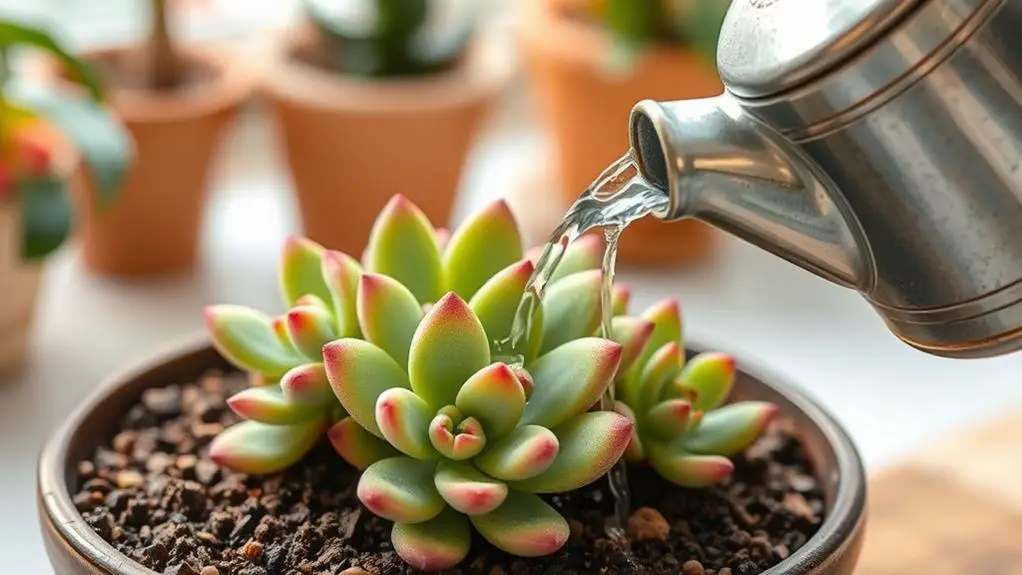
Watering your Kalanchoe tomentosa correctly is crucial for its health and growth. You should water your plant every time the top 2 inches of soil is completely dry. This succulent prefers dry conditions, so it's important not to overwater, a common issue that can lead to root rot.
To avoid this, make certain your pot has good drainage holes, allowing excess water to escape after you water it.
When you do water, give your Kalanchoe tomentosa a thorough soaking. This method guarantees the moisture reaches the root zone, promoting healthy growth. However, never leave your plant sitting in water, as this can cause waterlogging and damage the roots.
During the winter months, your Kalanchoe tomentosa enters a dormant phase and requires even less watering—typically every 2-3 weeks. Always check the soil before adding water to prevent overwatering.
Also, keep an eye on the humidity levels around your plant. Kalanchoe tomentosa thrives in drier environments, so avoid overly humid conditions that can lead to fungal infections.
Fertilization
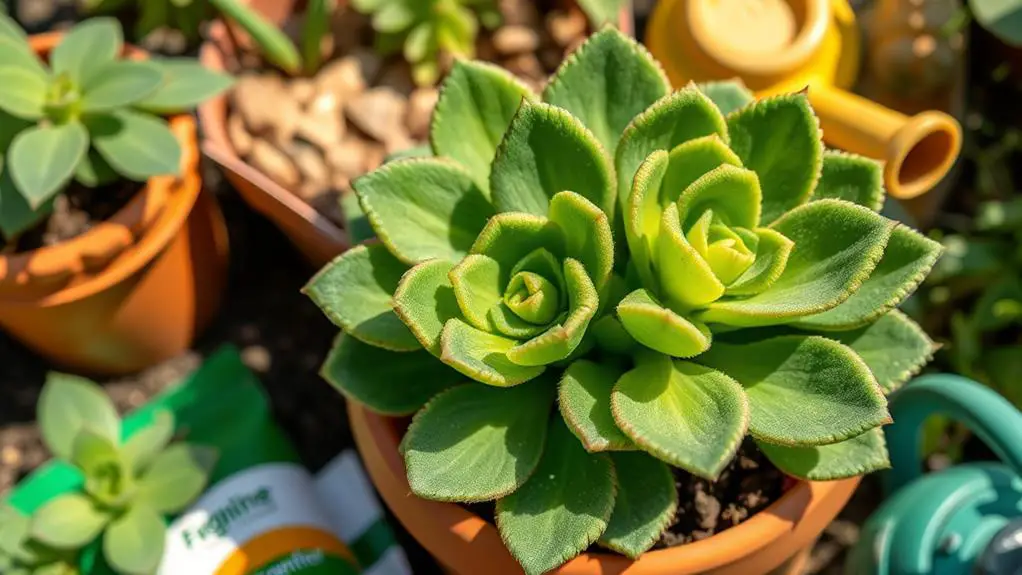
After mastering the watering techniques for your Kalanchoe tomentosa, you should also focus on proper fertilization to support its growth. Fertilizing your plant is key for guaranteeing healthy growth. During the growing season, which is spring and summer, feed your Kalanchoe tomentosa monthly with a diluted succulent fertilizer. This helps provide the nutrients it needs to thrive.
It's important to use a balanced fertilizer with low nitrogen content. Too much nitrogen can make the plant grow tall and weak, with poor leaf quality. Always water your plant before you add any fertilizer. This prevents root burn and helps the plant absorb nutrients better.
In the first year, don't fertilize your Kalanchoe tomentosa. Let it establish itself naturally without added nutrients. When winter comes, stop fertilizing. The plant goes dormant and doesn't need extra nutrients.
Here's a quick guide to fertilizing your Kalanchoe tomentosa:
| Season | Frequency | Important Tips |
|---|---|---|
| Spring | Monthly | Use diluted succulent fertilizer |
| Summer | Monthly | Guarantee low nitrogen content |
| Winter | None | Plant is dormant; avoid fertilization |
Propagation Methods
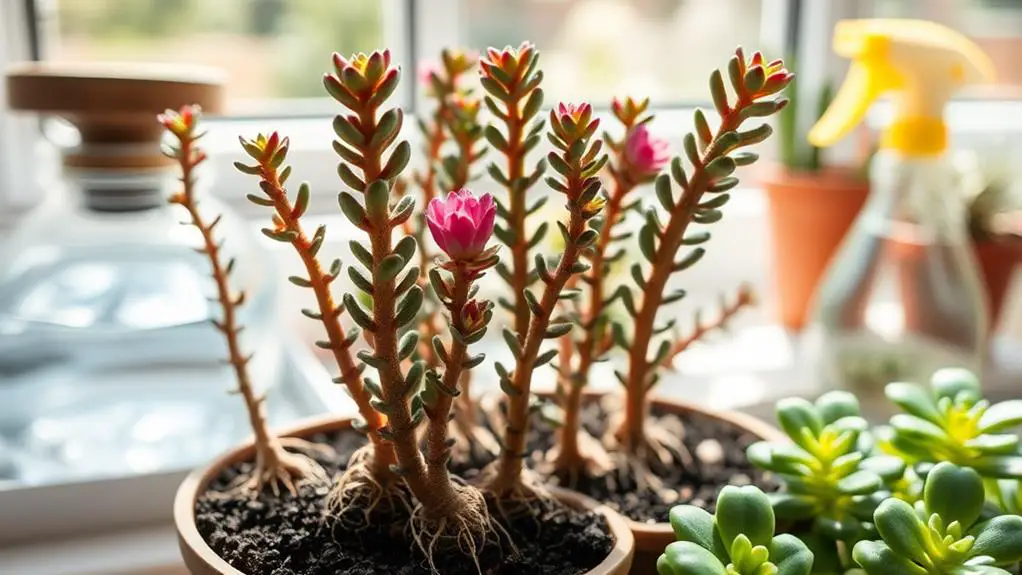
Now, let's talk about how you can grow new Kalanchoe tomentosa plants from cuttings.
You can use either leaf or stem cuttings, but stem cuttings usually work better.
For leaf cuttings, cut the leaves into 2-3 parts and let them dry for a few days before placing them on well-drained soil.
For stem cuttings, choose a healthy stem, let it dry, and then plant it in cactus soil.
Leaf Cutting Process
Propagating Kalanchoe tomentosa through leaf cuttings is a straightforward process that can yield thriving new plants. Start by cutting healthy leaves into 2-3 equal parts. Make sure each piece has clean leaf edges for ideal healing.
Lay the cut sections on a dry surface for 2-3 days to callus over. This step is essential to prevent rot.
Once the leaf sections have callused, place them on well-draining soil. It's important to use a cactus mix to avoid moisture build-up. Lightly mist the topsoil to maintain moisture, but don't water the plant too much. Over the next month, keep an eye on the soil. It should be slightly moist, not soggy, which is key for root development.
As roots begin to form, you'll see progress. When the cuttings have established roots, it's time to repot the new plants into individual pots.
Again, use well-draining soil to promote healthy growth and prevent root rot. By following these steps, you'll be able to propagate Kalanchoe tomentosa successfully. It's a rewarding process that adds beautiful new plants to your collection.
Happy gardening!
Stem Cutting Techniques
While leaf cuttings provide an excellent way to propagate Kalanchoe tomentosa, stem cutting techniques offer another reliable method to expand your plant collection.
Start by selecting a healthy stem with at least two leaves. Cut it cleanly and let it callus for 2-3 days to prevent rot. This step is vital to avoid moisture-related problems later.
Next, prepare a planter filled with well-draining cactus soil. Insert the calloused stem cutting into the soil, burying about two-thirds of the stem for stability. Make certain the soil is suitable for succulents, which helps in preventing waterlogging and rot.
After planting, water the topsoil lightly 1-3 times a week for three weeks. Keep the soil slightly moist, but don't overdo it. Too much moisture can lead to rot.
Once you notice roots forming, transfer the cutting to a spot with filtered sunlight. This light exposure is essential for healthy growth.
During this rooting process, monitor the cutting's moisture and light exposure closely. Proper care at this stage guarantees successful propagation and helps prevent issues like rot or fungal infections.
With these steps, you'll have a thriving Kalanchoe tomentosa in no time!
Common Issues and Solutions
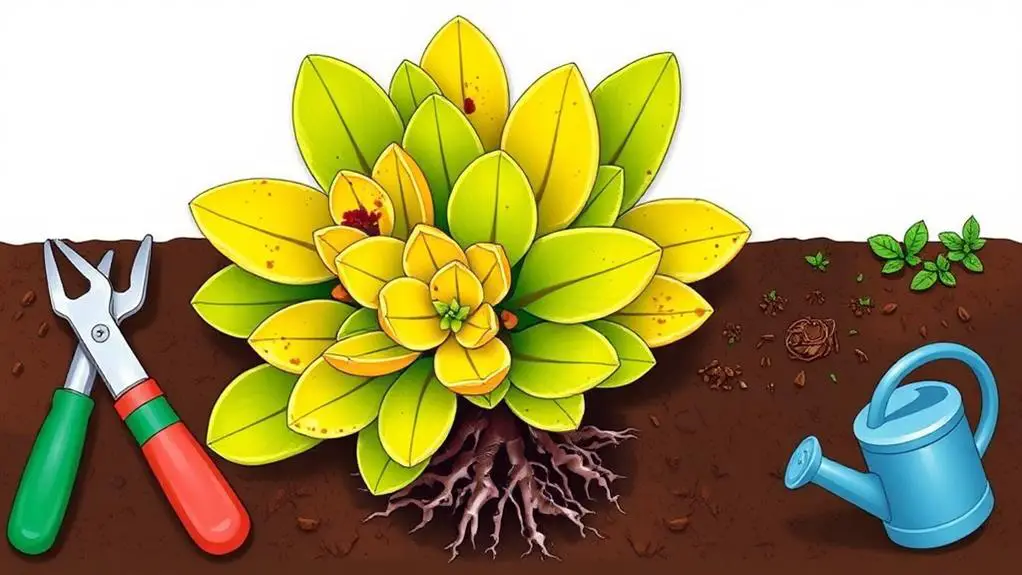
Caring for Kalanchoe tomentosa can sometimes be challenging, but addressing its common issues guarantees a healthy plant.
Let's tackle some of the most frequent problems you might encounter and their solutions.
1. Leaf Drop: This can be a sign of overwatering or poor drainage.
Adjust your watering habits, ensuring the soil dries out between waterings. Check that your pots have adequate drainage holes to prevent water from pooling.
2. Yellowing Leaves: Often, yellow leaves indicate a nutrient deficiency.
To fix this, provide a diluted succulent fertilizer monthly during the growing season. This will help keep your plant vibrant and healthy.
3. Stunted Growth: If your Kalanchoe tomentosa isn't growing well, it might be due to low light conditions.
Place your plant in bright, indirect sunlight to encourage healthy growth. Adequate light is essential for its development.
4. Pests: Regularly inspect your plant for pests like mealybugs and aphids.
If you find them, you can remove them manually or use neem oil as a treatment. Keeping an eye on your plant helps catch infestations early.
Frequently Asked Questions
How Do You Propagate Kalanchoe Tomentosa?
To propagate Kalanchoe tomentosa, take a healthy stem or leaf cutting. Let it callus for a few days, then plant it in well-draining soil. Keep the soil slightly moist and consider covering it to enhance humidity.
Will Kalanchoe Cuttings Root in Water?
Kalanchoe cuttings don't root well in water. Instead, let the cut ends callus for a few days, then plant them in well-draining soil. This method prevents rot and promotes healthier root development within 2-4 weeks.
How Do You Care for a Panda Plant Kalanchoe Tomentosa?
Place your Panda Plant in bright, indirect sunlight and water only when the top 2 inches of soil are dry. Use well-draining soil and maintain temperatures between 60°F and 75°F. Inspect regularly for pests and yellowing leaves.
Does Kalanchoe Tomentosa Like Sun or Shade?
Kalanchoe tomentosa thrives in bright, indirect sunlight. It can handle some direct sun, but too much can scorch its leaves. Place it near a south or west-facing window with filtered light. Avoid excessive direct sunlight.
Conclusion
You've got all the tools you need to care for your Kalanchoe Tomentosa. By providing the right light, temperature, and soil, you're setting your plant up for success. Remember to water it just enough and give it a little fertilizer during the growing season. If you want more of these fuzzy friends, try propagating them with leaf or stem cuttings. With these tips, you'll keep your Kalanchoe Tomentosa thriving and beautiful!

